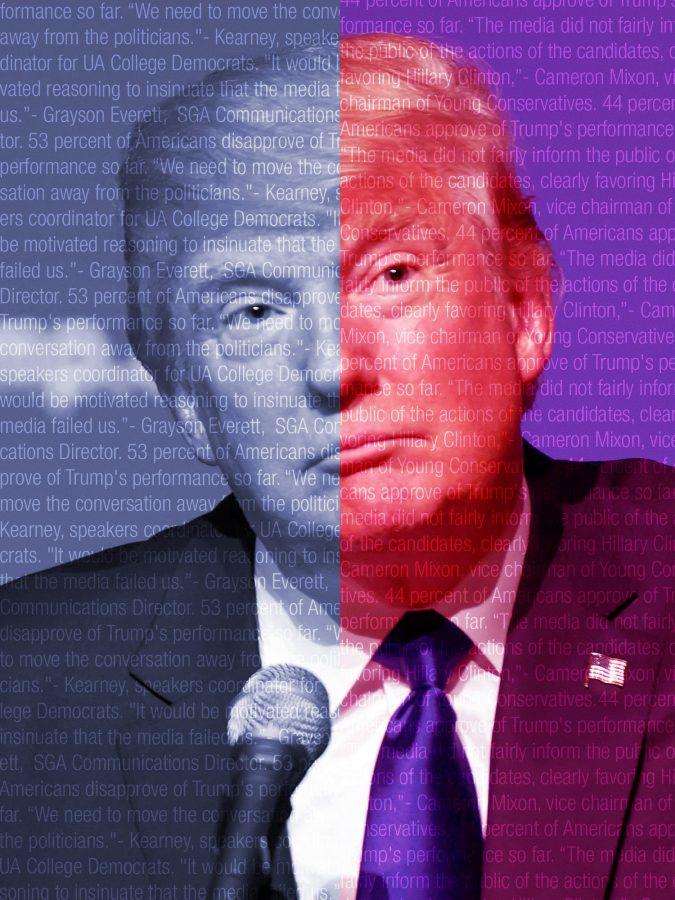According to Pew Research Center, people who share primarily liberal views or only conservative views has doubled, and those classified as moderates decreased. While Trump won the system that elects American presidents – the Electoral College – Hillary won the popular vote by a margin of almost three million.
Numbers also show that division has not improved in the three months since the election was decided. According to the latest CNN poll, 53 percent of Americans disapprove of Trump’s job so far, and 44 percent approve.
One of Trump’s most divisive stances between the political left and right is his approach to traditional media outlets. Throughout the campaign, Trump attacked mainstream institutions such as the New York Times, reverting to covering his own events via Twitter and Facebook Live. Recently, his press secretary, Sean Spicer, has called outlets such as CNN “fake news.”
Some liberals leaning students have been outraged by Trump’s treatment of journalists with whom he disagrees.
“He is trying to silence dissenting opinions,” said Sean Kearney, speakers coordinator for UA College Democrats. “People who support the stance Trump is taking will stay vehemently by his side, but everyone else will protest and fight for their freedoms.”
Some students fear a Trump administration that “shuts out” media outlets that challenge its agenda. On the other hand, some conservatives view the more aggressive posture as long overdue. To them, the mainstream media has never given them a fair shake or legitimate voice.
“The media did not fairly inform the public of the actions of the candidates, clearly favoring Hillary Clinton,” said Cameron Mixon, the vice chairman of Young Conservatives.
Criticism from right-leaning voices like Mixon is not uncommon. Such disdain for traditional media exists that many conservatives have retreated to their own outlets to avoid “liberal bias.” According to a press release, the alt-right publication Breitbart News accrued a record 240 million page views during the month of the election, and attracted 37 million separate visitors.
But not all accuse the media for Trump’s rise. SGA Communications Director Grayson Everett believes those that lash out so vehemently against the traditional media have an agenda to push.
“It would be motivated reasoning to insinuate that the media failed us,” said Everett, a sophomore majoring in communication studies and psychology. “With such an atypical election year, newsrooms had to run an atypical coverage strategy.”
Division has manifested visibly on the University’s campus, and people have protested the election of President Trump and his travel ban with a “March for Diversity.” Even before the election, BamaSits and Bama Stands created protests to take opposing stands on the national anthem.
“I believe that sometimes in American politics that people tend to focus on the candidates and parties rather than the issues,” Kearney said. “We need to move the conversation away from the politicians. People can usually agree that we need to constantly improve our education system, so the conversation needs to shift to these issues.”
Occupying a distinct spot on the political spectrum, libertarians, like those in UA’s chapter of Young Americans for Liberty, are in an interesting position when it comes to their historical mainstream allies: the Republicans. Trump’s trade and immigration policies directly contradict the core tenants of libertarian philosophy, according to UA YAL President Byron Solomon.
“From the wall, to the travel ban, Americans are right to feel divided from the world, immigrants, and their communities,” said Solomon, a senior majoring in history. “Libertarians have always championed freely flowing borders, and I think libertarians will be the ones standing up for immigrants and multiculturalism in America.”
According to Solomon, libertarians can ally with the Democrats to serve as a middle ground for discussion on the new president’s policies. “No matter what happens, libertarians have a role to play in keeping the U.S. united,” he said.
In the first three weeks, Trump has kept good on many of has campaign promises, much to the chagrin of liberals and libertarians. He has already pulled the U.S. out of the Trans-Pacific Partnership, issued restrictive immigration orders and banned the funding of international organizations that fund abortion.
Although Trump has moved fairly quickly, such speed is much less possible with one of his most prominent campaign promises: the border wall. Allen Linken, political science professor at The University, said Congress would have to allocate money for the wall, and Congress would be much less on board with this decision. Additionally, Trump has hit roadblocks with his policies in the judiciary, most recently the U.S. Court of Appeals for the Ninth Circuit.
The Ninth Circuit’s decision to uphold a nationwide temporary restraining order on Trump’s immigration policy has divided Americans, and returned the debate over the judiciary’s role to the center of current politics. This weekend, Saturday Night Live parodied the president’s response to the ruling in a sketch pitting him against the judges in “People’s Court.”
Conservatives, nonetheless, did not take kindly to the Ninth Circuit’s “judicial activism.” In the ruling, some believe the the judges overstepped their bounds to promote a political agenda.
“The decision was unconstitutional and completely defied what was required of the judges: to interpret the law as it is written,” said Daniel Ashford, the Treasurer for UA’s Young Conservatives. “I feel it will be overturned at U.S. Supreme Court.”









